Mental Health Issues Among Women in Australia
VerifiedAdded on 2023/01/20
|12
|2835
|83
AI Summary
This report discusses the mental health issues faced by women in Australia, including the determinants and factors contributing to these issues. It also explores the health promotion model and the municipal public health and wellbeing plan implemented to address these concerns.
Contribute Materials
Your contribution can guide someone’s learning journey. Share your
documents today.
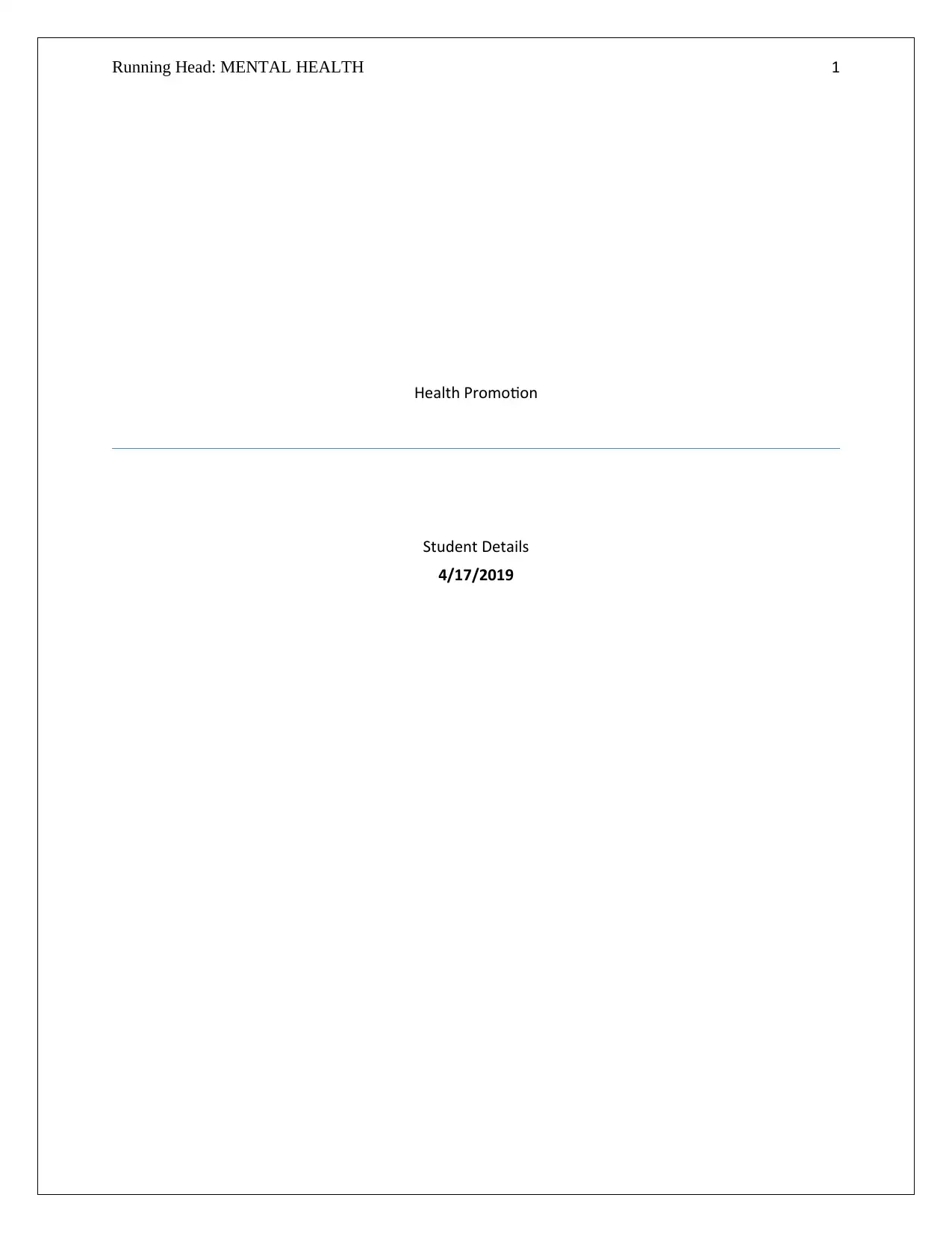
Running Head: MENTAL HEALTH 1
Health Promotion
Student Details
4/17/2019
Health Promotion
Student Details
4/17/2019
Secure Best Marks with AI Grader
Need help grading? Try our AI Grader for instant feedback on your assignments.
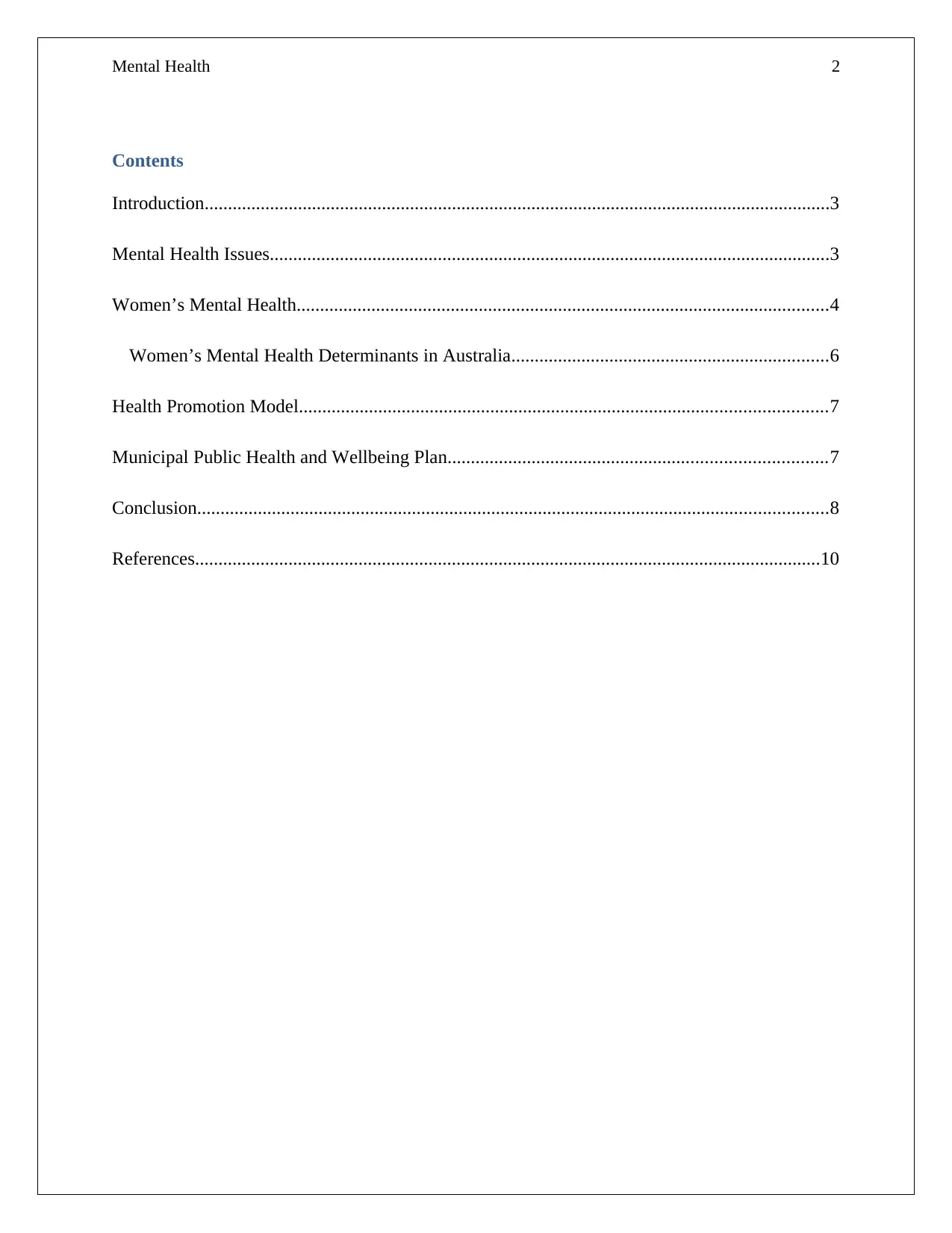
Mental Health 2
Contents
Introduction......................................................................................................................................3
Mental Health Issues........................................................................................................................3
Women’s Mental Health..................................................................................................................4
Women’s Mental Health Determinants in Australia....................................................................6
Health Promotion Model.................................................................................................................7
Municipal Public Health and Wellbeing Plan.................................................................................7
Conclusion.......................................................................................................................................8
References......................................................................................................................................10
Contents
Introduction......................................................................................................................................3
Mental Health Issues........................................................................................................................3
Women’s Mental Health..................................................................................................................4
Women’s Mental Health Determinants in Australia....................................................................6
Health Promotion Model.................................................................................................................7
Municipal Public Health and Wellbeing Plan.................................................................................7
Conclusion.......................................................................................................................................8
References......................................................................................................................................10
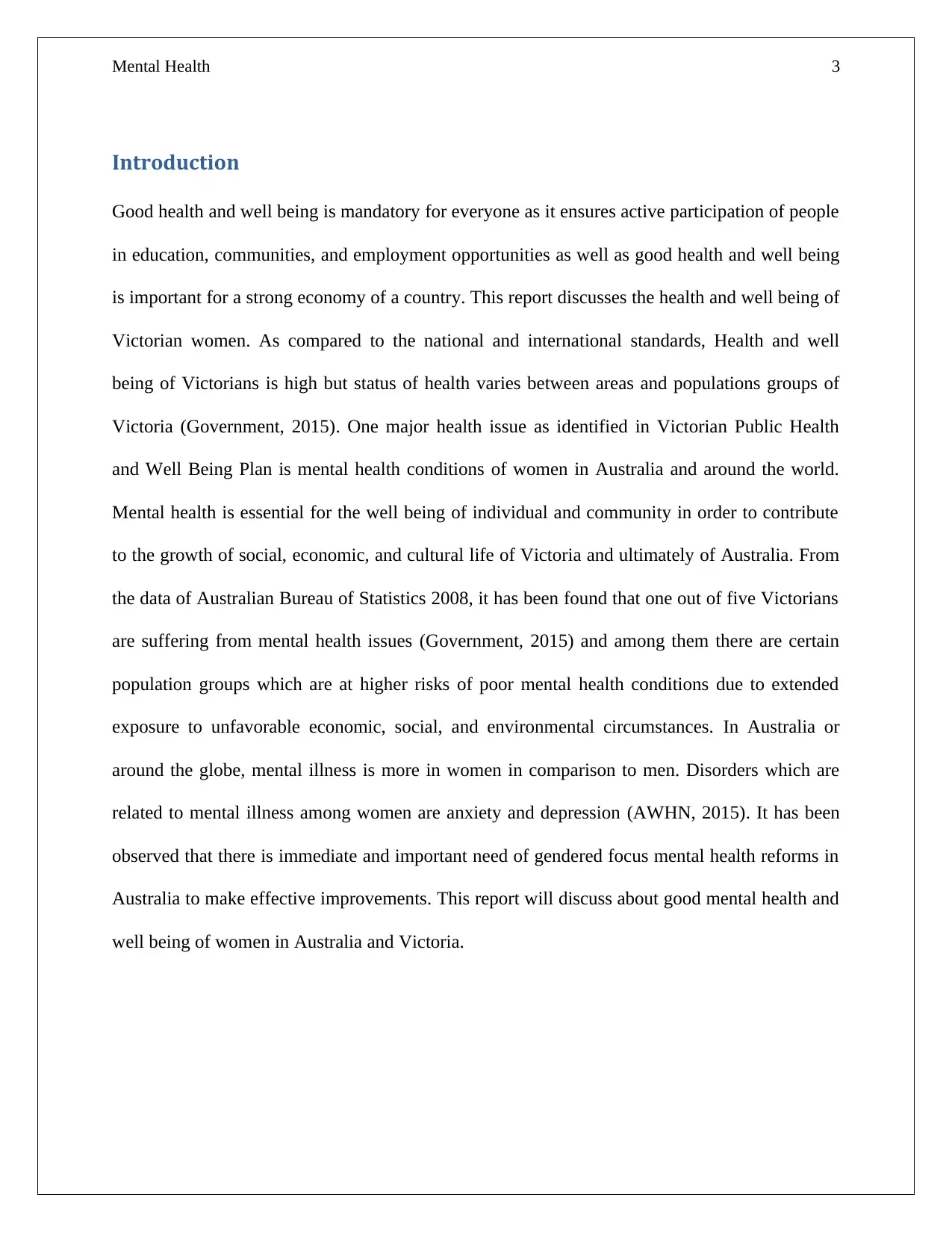
Mental Health 3
Introduction
Good health and well being is mandatory for everyone as it ensures active participation of people
in education, communities, and employment opportunities as well as good health and well being
is important for a strong economy of a country. This report discusses the health and well being of
Victorian women. As compared to the national and international standards, Health and well
being of Victorians is high but status of health varies between areas and populations groups of
Victoria (Government, 2015). One major health issue as identified in Victorian Public Health
and Well Being Plan is mental health conditions of women in Australia and around the world.
Mental health is essential for the well being of individual and community in order to contribute
to the growth of social, economic, and cultural life of Victoria and ultimately of Australia. From
the data of Australian Bureau of Statistics 2008, it has been found that one out of five Victorians
are suffering from mental health issues (Government, 2015) and among them there are certain
population groups which are at higher risks of poor mental health conditions due to extended
exposure to unfavorable economic, social, and environmental circumstances. In Australia or
around the globe, mental illness is more in women in comparison to men. Disorders which are
related to mental illness among women are anxiety and depression (AWHN, 2015). It has been
observed that there is immediate and important need of gendered focus mental health reforms in
Australia to make effective improvements. This report will discuss about good mental health and
well being of women in Australia and Victoria.
Introduction
Good health and well being is mandatory for everyone as it ensures active participation of people
in education, communities, and employment opportunities as well as good health and well being
is important for a strong economy of a country. This report discusses the health and well being of
Victorian women. As compared to the national and international standards, Health and well
being of Victorians is high but status of health varies between areas and populations groups of
Victoria (Government, 2015). One major health issue as identified in Victorian Public Health
and Well Being Plan is mental health conditions of women in Australia and around the world.
Mental health is essential for the well being of individual and community in order to contribute
to the growth of social, economic, and cultural life of Victoria and ultimately of Australia. From
the data of Australian Bureau of Statistics 2008, it has been found that one out of five Victorians
are suffering from mental health issues (Government, 2015) and among them there are certain
population groups which are at higher risks of poor mental health conditions due to extended
exposure to unfavorable economic, social, and environmental circumstances. In Australia or
around the globe, mental illness is more in women in comparison to men. Disorders which are
related to mental illness among women are anxiety and depression (AWHN, 2015). It has been
observed that there is immediate and important need of gendered focus mental health reforms in
Australia to make effective improvements. This report will discuss about good mental health and
well being of women in Australia and Victoria.
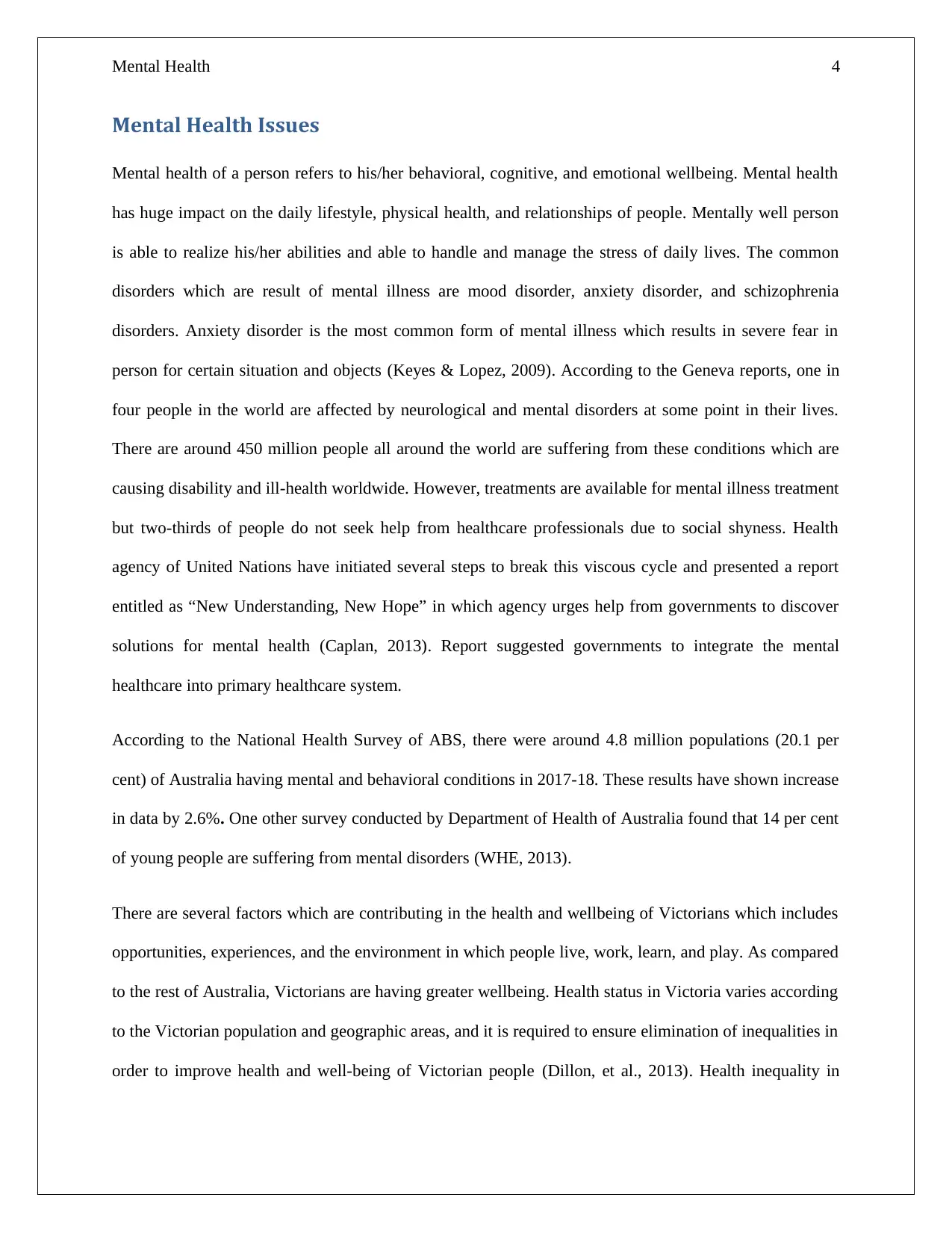
Mental Health 4
Mental Health Issues
Mental health of a person refers to his/her behavioral, cognitive, and emotional wellbeing. Mental health
has huge impact on the daily lifestyle, physical health, and relationships of people. Mentally well person
is able to realize his/her abilities and able to handle and manage the stress of daily lives. The common
disorders which are result of mental illness are mood disorder, anxiety disorder, and schizophrenia
disorders. Anxiety disorder is the most common form of mental illness which results in severe fear in
person for certain situation and objects (Keyes & Lopez, 2009). According to the Geneva reports, one in
four people in the world are affected by neurological and mental disorders at some point in their lives.
There are around 450 million people all around the world are suffering from these conditions which are
causing disability and ill-health worldwide. However, treatments are available for mental illness treatment
but two-thirds of people do not seek help from healthcare professionals due to social shyness. Health
agency of United Nations have initiated several steps to break this viscous cycle and presented a report
entitled as “New Understanding, New Hope” in which agency urges help from governments to discover
solutions for mental health (Caplan, 2013). Report suggested governments to integrate the mental
healthcare into primary healthcare system.
According to the National Health Survey of ABS, there were around 4.8 million populations (20.1 per
cent) of Australia having mental and behavioral conditions in 2017-18. These results have shown increase
in data by 2.6%. One other survey conducted by Department of Health of Australia found that 14 per cent
of young people are suffering from mental disorders (WHE, 2013).
There are several factors which are contributing in the health and wellbeing of Victorians which includes
opportunities, experiences, and the environment in which people live, work, learn, and play. As compared
to the rest of Australia, Victorians are having greater wellbeing. Health status in Victoria varies according
to the Victorian population and geographic areas, and it is required to ensure elimination of inequalities in
order to improve health and well-being of Victorian people (Dillon, et al., 2013). Health inequality in
Mental Health Issues
Mental health of a person refers to his/her behavioral, cognitive, and emotional wellbeing. Mental health
has huge impact on the daily lifestyle, physical health, and relationships of people. Mentally well person
is able to realize his/her abilities and able to handle and manage the stress of daily lives. The common
disorders which are result of mental illness are mood disorder, anxiety disorder, and schizophrenia
disorders. Anxiety disorder is the most common form of mental illness which results in severe fear in
person for certain situation and objects (Keyes & Lopez, 2009). According to the Geneva reports, one in
four people in the world are affected by neurological and mental disorders at some point in their lives.
There are around 450 million people all around the world are suffering from these conditions which are
causing disability and ill-health worldwide. However, treatments are available for mental illness treatment
but two-thirds of people do not seek help from healthcare professionals due to social shyness. Health
agency of United Nations have initiated several steps to break this viscous cycle and presented a report
entitled as “New Understanding, New Hope” in which agency urges help from governments to discover
solutions for mental health (Caplan, 2013). Report suggested governments to integrate the mental
healthcare into primary healthcare system.
According to the National Health Survey of ABS, there were around 4.8 million populations (20.1 per
cent) of Australia having mental and behavioral conditions in 2017-18. These results have shown increase
in data by 2.6%. One other survey conducted by Department of Health of Australia found that 14 per cent
of young people are suffering from mental disorders (WHE, 2013).
There are several factors which are contributing in the health and wellbeing of Victorians which includes
opportunities, experiences, and the environment in which people live, work, learn, and play. As compared
to the rest of Australia, Victorians are having greater wellbeing. Health status in Victoria varies according
to the Victorian population and geographic areas, and it is required to ensure elimination of inequalities in
order to improve health and well-being of Victorian people (Dillon, et al., 2013). Health inequality in
Secure Best Marks with AI Grader
Need help grading? Try our AI Grader for instant feedback on your assignments.
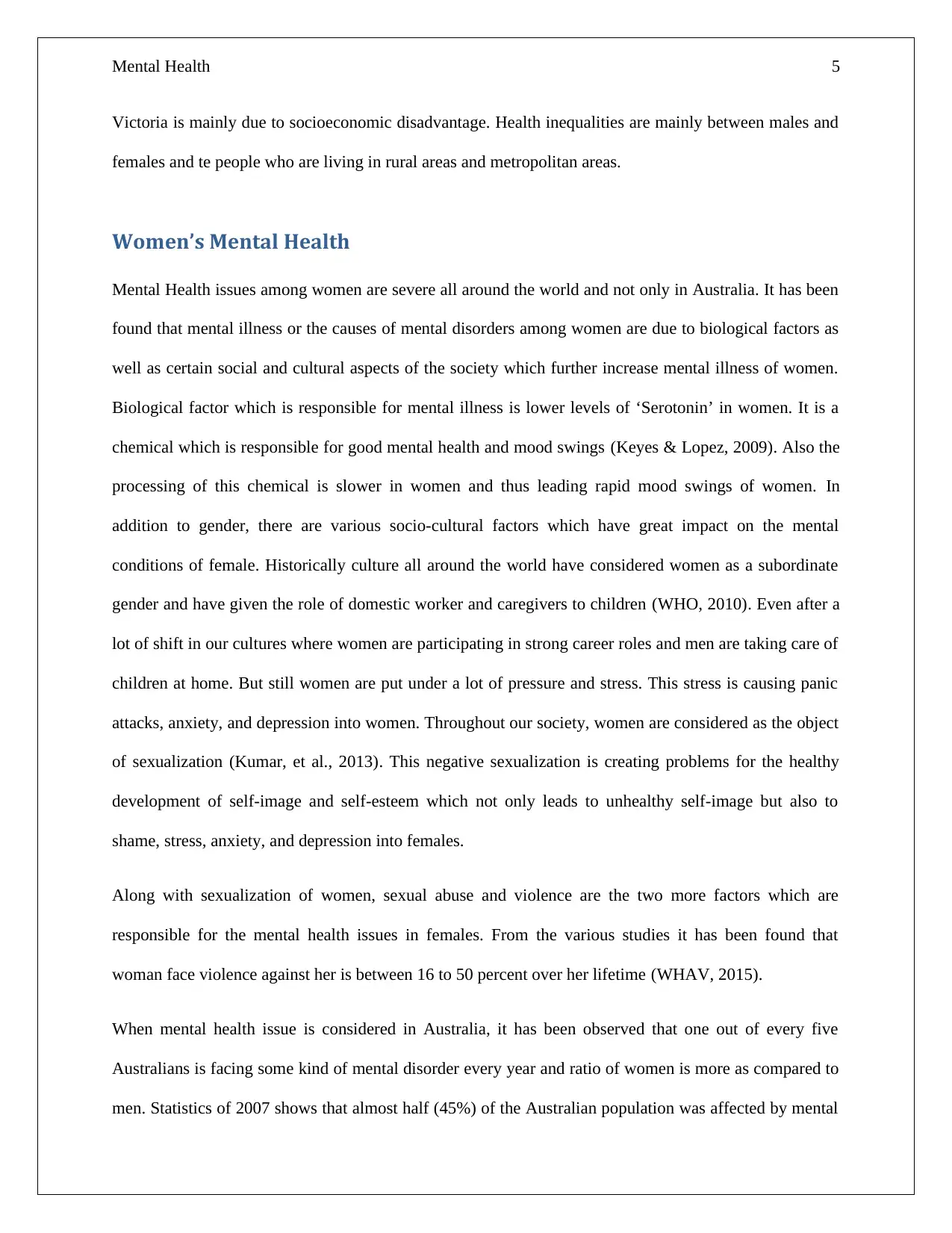
Mental Health 5
Victoria is mainly due to socioeconomic disadvantage. Health inequalities are mainly between males and
females and te people who are living in rural areas and metropolitan areas.
Women’s Mental Health
Mental Health issues among women are severe all around the world and not only in Australia. It has been
found that mental illness or the causes of mental disorders among women are due to biological factors as
well as certain social and cultural aspects of the society which further increase mental illness of women.
Biological factor which is responsible for mental illness is lower levels of ‘Serotonin’ in women. It is a
chemical which is responsible for good mental health and mood swings (Keyes & Lopez, 2009). Also the
processing of this chemical is slower in women and thus leading rapid mood swings of women. In
addition to gender, there are various socio-cultural factors which have great impact on the mental
conditions of female. Historically culture all around the world have considered women as a subordinate
gender and have given the role of domestic worker and caregivers to children (WHO, 2010). Even after a
lot of shift in our cultures where women are participating in strong career roles and men are taking care of
children at home. But still women are put under a lot of pressure and stress. This stress is causing panic
attacks, anxiety, and depression into women. Throughout our society, women are considered as the object
of sexualization (Kumar, et al., 2013). This negative sexualization is creating problems for the healthy
development of self-image and self-esteem which not only leads to unhealthy self-image but also to
shame, stress, anxiety, and depression into females.
Along with sexualization of women, sexual abuse and violence are the two more factors which are
responsible for the mental health issues in females. From the various studies it has been found that
woman face violence against her is between 16 to 50 percent over her lifetime (WHAV, 2015).
When mental health issue is considered in Australia, it has been observed that one out of every five
Australians is facing some kind of mental disorder every year and ratio of women is more as compared to
men. Statistics of 2007 shows that almost half (45%) of the Australian population was affected by mental
Victoria is mainly due to socioeconomic disadvantage. Health inequalities are mainly between males and
females and te people who are living in rural areas and metropolitan areas.
Women’s Mental Health
Mental Health issues among women are severe all around the world and not only in Australia. It has been
found that mental illness or the causes of mental disorders among women are due to biological factors as
well as certain social and cultural aspects of the society which further increase mental illness of women.
Biological factor which is responsible for mental illness is lower levels of ‘Serotonin’ in women. It is a
chemical which is responsible for good mental health and mood swings (Keyes & Lopez, 2009). Also the
processing of this chemical is slower in women and thus leading rapid mood swings of women. In
addition to gender, there are various socio-cultural factors which have great impact on the mental
conditions of female. Historically culture all around the world have considered women as a subordinate
gender and have given the role of domestic worker and caregivers to children (WHO, 2010). Even after a
lot of shift in our cultures where women are participating in strong career roles and men are taking care of
children at home. But still women are put under a lot of pressure and stress. This stress is causing panic
attacks, anxiety, and depression into women. Throughout our society, women are considered as the object
of sexualization (Kumar, et al., 2013). This negative sexualization is creating problems for the healthy
development of self-image and self-esteem which not only leads to unhealthy self-image but also to
shame, stress, anxiety, and depression into females.
Along with sexualization of women, sexual abuse and violence are the two more factors which are
responsible for the mental health issues in females. From the various studies it has been found that
woman face violence against her is between 16 to 50 percent over her lifetime (WHAV, 2015).
When mental health issue is considered in Australia, it has been observed that one out of every five
Australians is facing some kind of mental disorder every year and ratio of women is more as compared to
men. Statistics of 2007 shows that almost half (45%) of the Australian population was affected by mental
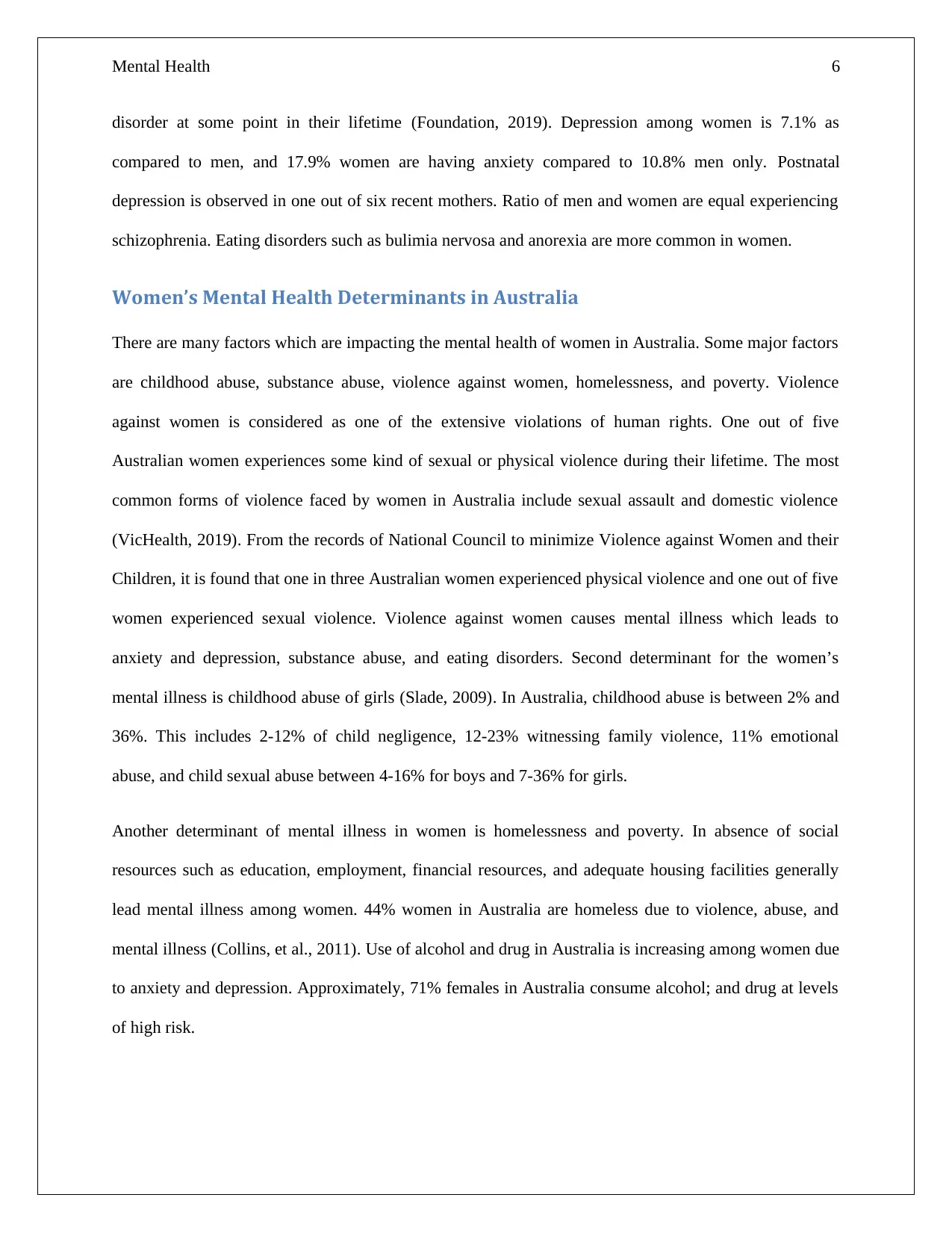
Mental Health 6
disorder at some point in their lifetime (Foundation, 2019). Depression among women is 7.1% as
compared to men, and 17.9% women are having anxiety compared to 10.8% men only. Postnatal
depression is observed in one out of six recent mothers. Ratio of men and women are equal experiencing
schizophrenia. Eating disorders such as bulimia nervosa and anorexia are more common in women.
Women’s Mental Health Determinants in Australia
There are many factors which are impacting the mental health of women in Australia. Some major factors
are childhood abuse, substance abuse, violence against women, homelessness, and poverty. Violence
against women is considered as one of the extensive violations of human rights. One out of five
Australian women experiences some kind of sexual or physical violence during their lifetime. The most
common forms of violence faced by women in Australia include sexual assault and domestic violence
(VicHealth, 2019). From the records of National Council to minimize Violence against Women and their
Children, it is found that one in three Australian women experienced physical violence and one out of five
women experienced sexual violence. Violence against women causes mental illness which leads to
anxiety and depression, substance abuse, and eating disorders. Second determinant for the women’s
mental illness is childhood abuse of girls (Slade, 2009). In Australia, childhood abuse is between 2% and
36%. This includes 2-12% of child negligence, 12-23% witnessing family violence, 11% emotional
abuse, and child sexual abuse between 4-16% for boys and 7-36% for girls.
Another determinant of mental illness in women is homelessness and poverty. In absence of social
resources such as education, employment, financial resources, and adequate housing facilities generally
lead mental illness among women. 44% women in Australia are homeless due to violence, abuse, and
mental illness (Collins, et al., 2011). Use of alcohol and drug in Australia is increasing among women due
to anxiety and depression. Approximately, 71% females in Australia consume alcohol; and drug at levels
of high risk.
disorder at some point in their lifetime (Foundation, 2019). Depression among women is 7.1% as
compared to men, and 17.9% women are having anxiety compared to 10.8% men only. Postnatal
depression is observed in one out of six recent mothers. Ratio of men and women are equal experiencing
schizophrenia. Eating disorders such as bulimia nervosa and anorexia are more common in women.
Women’s Mental Health Determinants in Australia
There are many factors which are impacting the mental health of women in Australia. Some major factors
are childhood abuse, substance abuse, violence against women, homelessness, and poverty. Violence
against women is considered as one of the extensive violations of human rights. One out of five
Australian women experiences some kind of sexual or physical violence during their lifetime. The most
common forms of violence faced by women in Australia include sexual assault and domestic violence
(VicHealth, 2019). From the records of National Council to minimize Violence against Women and their
Children, it is found that one in three Australian women experienced physical violence and one out of five
women experienced sexual violence. Violence against women causes mental illness which leads to
anxiety and depression, substance abuse, and eating disorders. Second determinant for the women’s
mental illness is childhood abuse of girls (Slade, 2009). In Australia, childhood abuse is between 2% and
36%. This includes 2-12% of child negligence, 12-23% witnessing family violence, 11% emotional
abuse, and child sexual abuse between 4-16% for boys and 7-36% for girls.
Another determinant of mental illness in women is homelessness and poverty. In absence of social
resources such as education, employment, financial resources, and adequate housing facilities generally
lead mental illness among women. 44% women in Australia are homeless due to violence, abuse, and
mental illness (Collins, et al., 2011). Use of alcohol and drug in Australia is increasing among women due
to anxiety and depression. Approximately, 71% females in Australia consume alcohol; and drug at levels
of high risk.
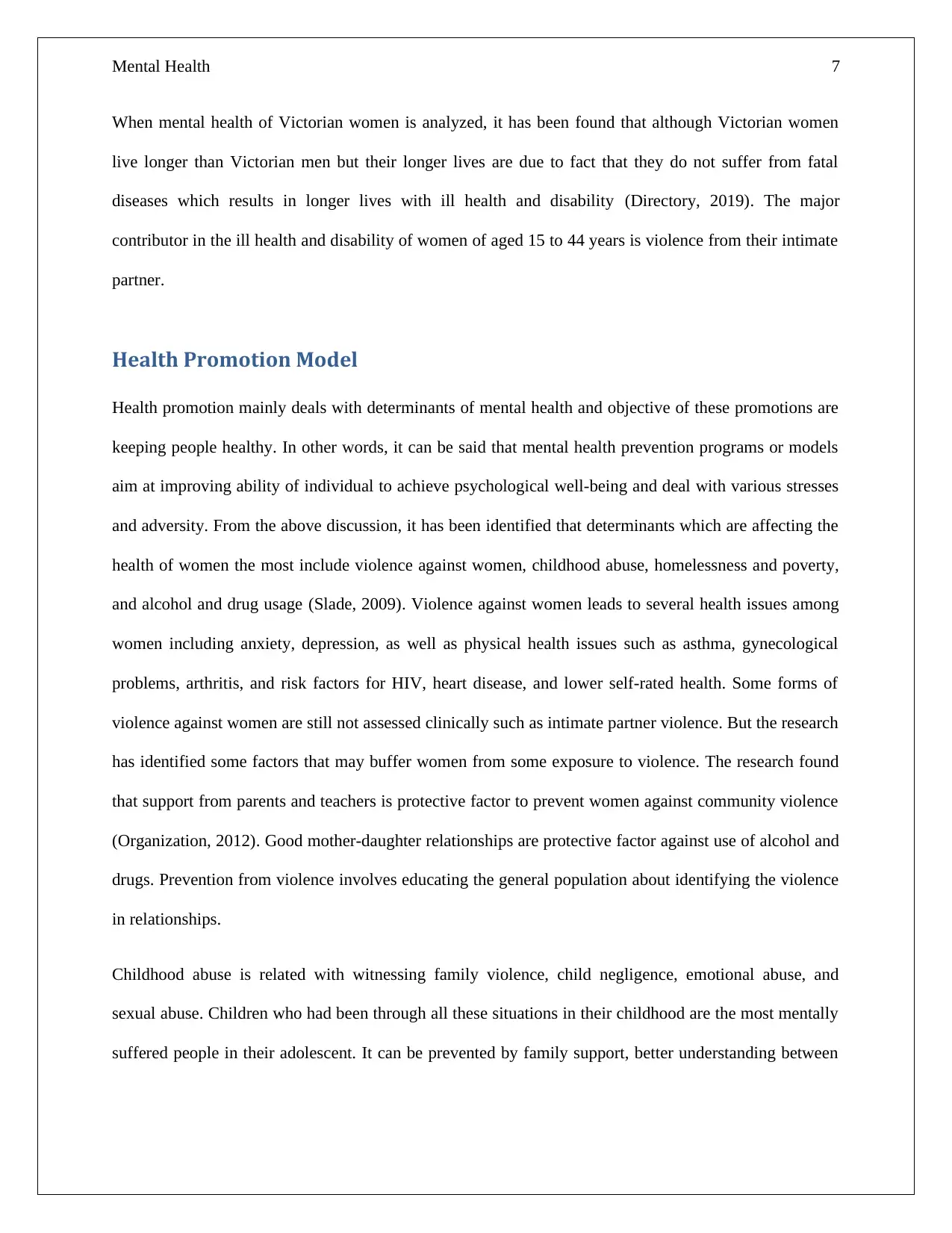
Mental Health 7
When mental health of Victorian women is analyzed, it has been found that although Victorian women
live longer than Victorian men but their longer lives are due to fact that they do not suffer from fatal
diseases which results in longer lives with ill health and disability (Directory, 2019). The major
contributor in the ill health and disability of women of aged 15 to 44 years is violence from their intimate
partner.
Health Promotion Model
Health promotion mainly deals with determinants of mental health and objective of these promotions are
keeping people healthy. In other words, it can be said that mental health prevention programs or models
aim at improving ability of individual to achieve psychological well-being and deal with various stresses
and adversity. From the above discussion, it has been identified that determinants which are affecting the
health of women the most include violence against women, childhood abuse, homelessness and poverty,
and alcohol and drug usage (Slade, 2009). Violence against women leads to several health issues among
women including anxiety, depression, as well as physical health issues such as asthma, gynecological
problems, arthritis, and risk factors for HIV, heart disease, and lower self-rated health. Some forms of
violence against women are still not assessed clinically such as intimate partner violence. But the research
has identified some factors that may buffer women from some exposure to violence. The research found
that support from parents and teachers is protective factor to prevent women against community violence
(Organization, 2012). Good mother-daughter relationships are protective factor against use of alcohol and
drugs. Prevention from violence involves educating the general population about identifying the violence
in relationships.
Childhood abuse is related with witnessing family violence, child negligence, emotional abuse, and
sexual abuse. Children who had been through all these situations in their childhood are the most mentally
suffered people in their adolescent. It can be prevented by family support, better understanding between
When mental health of Victorian women is analyzed, it has been found that although Victorian women
live longer than Victorian men but their longer lives are due to fact that they do not suffer from fatal
diseases which results in longer lives with ill health and disability (Directory, 2019). The major
contributor in the ill health and disability of women of aged 15 to 44 years is violence from their intimate
partner.
Health Promotion Model
Health promotion mainly deals with determinants of mental health and objective of these promotions are
keeping people healthy. In other words, it can be said that mental health prevention programs or models
aim at improving ability of individual to achieve psychological well-being and deal with various stresses
and adversity. From the above discussion, it has been identified that determinants which are affecting the
health of women the most include violence against women, childhood abuse, homelessness and poverty,
and alcohol and drug usage (Slade, 2009). Violence against women leads to several health issues among
women including anxiety, depression, as well as physical health issues such as asthma, gynecological
problems, arthritis, and risk factors for HIV, heart disease, and lower self-rated health. Some forms of
violence against women are still not assessed clinically such as intimate partner violence. But the research
has identified some factors that may buffer women from some exposure to violence. The research found
that support from parents and teachers is protective factor to prevent women against community violence
(Organization, 2012). Good mother-daughter relationships are protective factor against use of alcohol and
drugs. Prevention from violence involves educating the general population about identifying the violence
in relationships.
Childhood abuse is related with witnessing family violence, child negligence, emotional abuse, and
sexual abuse. Children who had been through all these situations in their childhood are the most mentally
suffered people in their adolescent. It can be prevented by family support, better understanding between
Paraphrase This Document
Need a fresh take? Get an instant paraphrase of this document with our AI Paraphraser
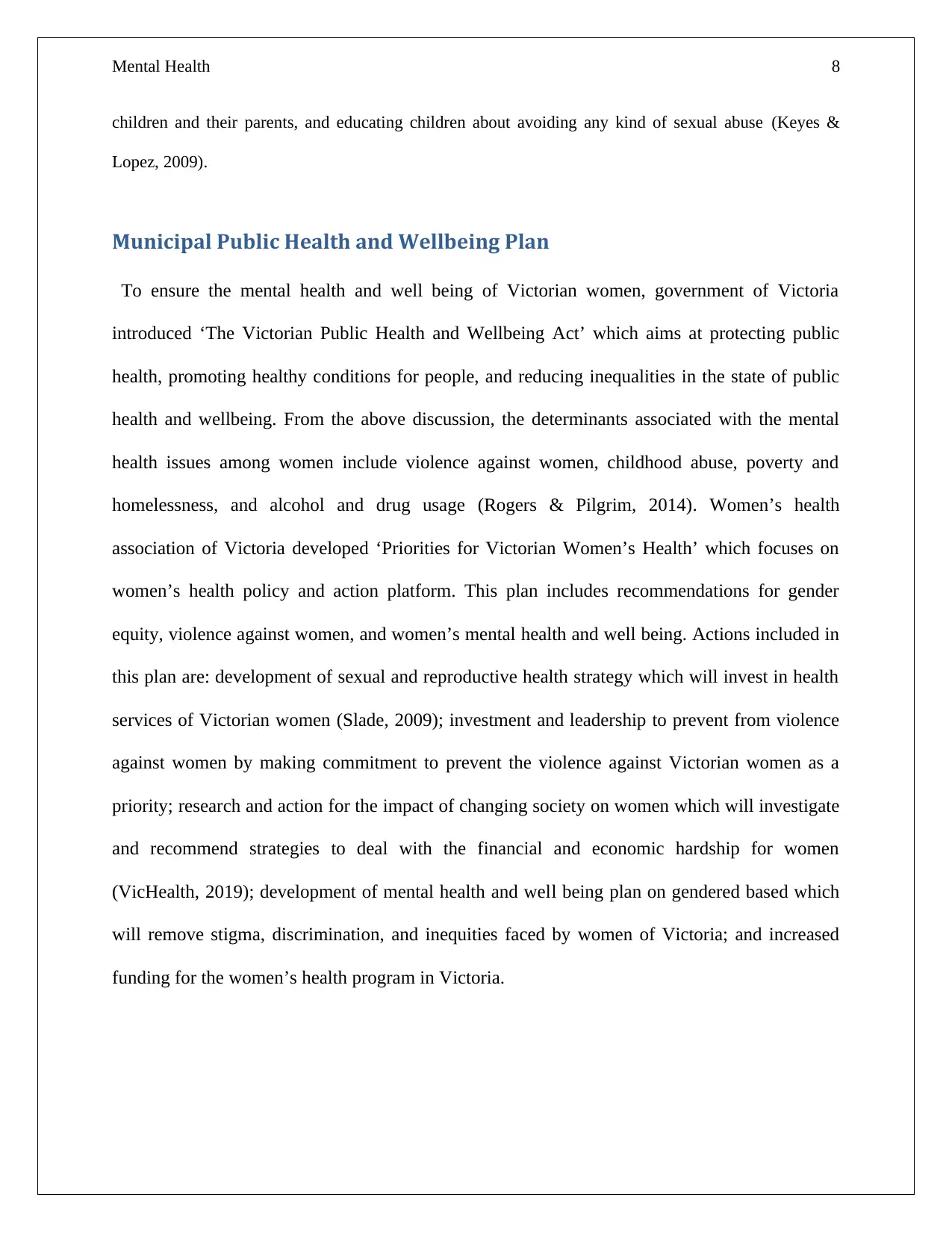
Mental Health 8
children and their parents, and educating children about avoiding any kind of sexual abuse (Keyes &
Lopez, 2009).
Municipal Public Health and Wellbeing Plan
To ensure the mental health and well being of Victorian women, government of Victoria
introduced ‘The Victorian Public Health and Wellbeing Act’ which aims at protecting public
health, promoting healthy conditions for people, and reducing inequalities in the state of public
health and wellbeing. From the above discussion, the determinants associated with the mental
health issues among women include violence against women, childhood abuse, poverty and
homelessness, and alcohol and drug usage (Rogers & Pilgrim, 2014). Women’s health
association of Victoria developed ‘Priorities for Victorian Women’s Health’ which focuses on
women’s health policy and action platform. This plan includes recommendations for gender
equity, violence against women, and women’s mental health and well being. Actions included in
this plan are: development of sexual and reproductive health strategy which will invest in health
services of Victorian women (Slade, 2009); investment and leadership to prevent from violence
against women by making commitment to prevent the violence against Victorian women as a
priority; research and action for the impact of changing society on women which will investigate
and recommend strategies to deal with the financial and economic hardship for women
(VicHealth, 2019); development of mental health and well being plan on gendered based which
will remove stigma, discrimination, and inequities faced by women of Victoria; and increased
funding for the women’s health program in Victoria.
children and their parents, and educating children about avoiding any kind of sexual abuse (Keyes &
Lopez, 2009).
Municipal Public Health and Wellbeing Plan
To ensure the mental health and well being of Victorian women, government of Victoria
introduced ‘The Victorian Public Health and Wellbeing Act’ which aims at protecting public
health, promoting healthy conditions for people, and reducing inequalities in the state of public
health and wellbeing. From the above discussion, the determinants associated with the mental
health issues among women include violence against women, childhood abuse, poverty and
homelessness, and alcohol and drug usage (Rogers & Pilgrim, 2014). Women’s health
association of Victoria developed ‘Priorities for Victorian Women’s Health’ which focuses on
women’s health policy and action platform. This plan includes recommendations for gender
equity, violence against women, and women’s mental health and well being. Actions included in
this plan are: development of sexual and reproductive health strategy which will invest in health
services of Victorian women (Slade, 2009); investment and leadership to prevent from violence
against women by making commitment to prevent the violence against Victorian women as a
priority; research and action for the impact of changing society on women which will investigate
and recommend strategies to deal with the financial and economic hardship for women
(VicHealth, 2019); development of mental health and well being plan on gendered based which
will remove stigma, discrimination, and inequities faced by women of Victoria; and increased
funding for the women’s health program in Victoria.
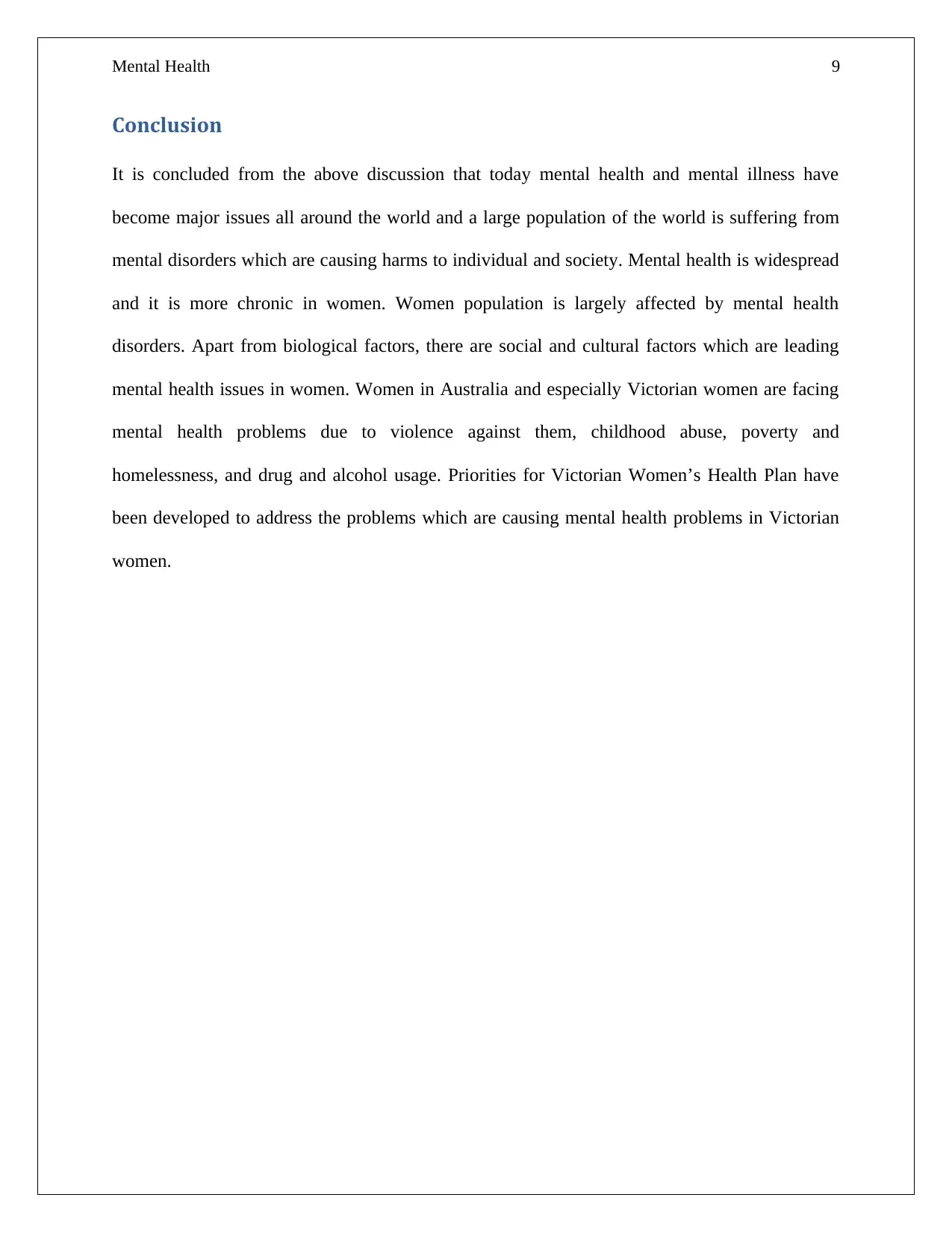
Mental Health 9
Conclusion
It is concluded from the above discussion that today mental health and mental illness have
become major issues all around the world and a large population of the world is suffering from
mental disorders which are causing harms to individual and society. Mental health is widespread
and it is more chronic in women. Women population is largely affected by mental health
disorders. Apart from biological factors, there are social and cultural factors which are leading
mental health issues in women. Women in Australia and especially Victorian women are facing
mental health problems due to violence against them, childhood abuse, poverty and
homelessness, and drug and alcohol usage. Priorities for Victorian Women’s Health Plan have
been developed to address the problems which are causing mental health problems in Victorian
women.
Conclusion
It is concluded from the above discussion that today mental health and mental illness have
become major issues all around the world and a large population of the world is suffering from
mental disorders which are causing harms to individual and society. Mental health is widespread
and it is more chronic in women. Women population is largely affected by mental health
disorders. Apart from biological factors, there are social and cultural factors which are leading
mental health issues in women. Women in Australia and especially Victorian women are facing
mental health problems due to violence against them, childhood abuse, poverty and
homelessness, and drug and alcohol usage. Priorities for Victorian Women’s Health Plan have
been developed to address the problems which are causing mental health problems in Victorian
women.
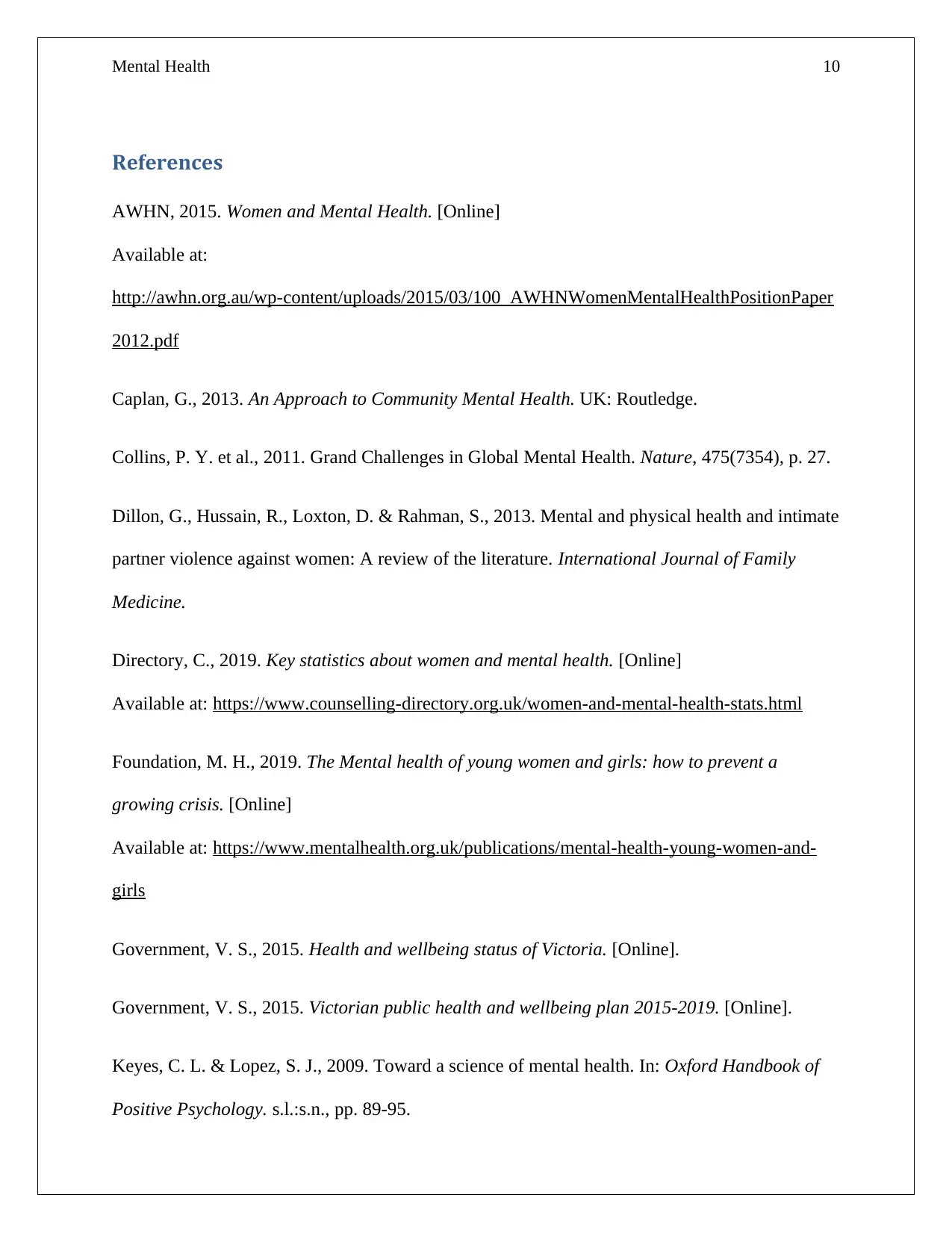
Mental Health 10
References
AWHN, 2015. Women and Mental Health. [Online]
Available at:
http://awhn.org.au/wp-content/uploads/2015/03/100_AWHNWomenMentalHealthPositionPaper
2012.pdf
Caplan, G., 2013. An Approach to Community Mental Health. UK: Routledge.
Collins, P. Y. et al., 2011. Grand Challenges in Global Mental Health. Nature, 475(7354), p. 27.
Dillon, G., Hussain, R., Loxton, D. & Rahman, S., 2013. Mental and physical health and intimate
partner violence against women: A review of the literature. International Journal of Family
Medicine.
Directory, C., 2019. Key statistics about women and mental health. [Online]
Available at: https://www.counselling-directory.org.uk/women-and-mental-health-stats.html
Foundation, M. H., 2019. The Mental health of young women and girls: how to prevent a
growing crisis. [Online]
Available at: https://www.mentalhealth.org.uk/publications/mental-health-young-women-and-
girls
Government, V. S., 2015. Health and wellbeing status of Victoria. [Online].
Government, V. S., 2015. Victorian public health and wellbeing plan 2015-2019. [Online].
Keyes, C. L. & Lopez, S. J., 2009. Toward a science of mental health. In: Oxford Handbook of
Positive Psychology. s.l.:s.n., pp. 89-95.
References
AWHN, 2015. Women and Mental Health. [Online]
Available at:
http://awhn.org.au/wp-content/uploads/2015/03/100_AWHNWomenMentalHealthPositionPaper
2012.pdf
Caplan, G., 2013. An Approach to Community Mental Health. UK: Routledge.
Collins, P. Y. et al., 2011. Grand Challenges in Global Mental Health. Nature, 475(7354), p. 27.
Dillon, G., Hussain, R., Loxton, D. & Rahman, S., 2013. Mental and physical health and intimate
partner violence against women: A review of the literature. International Journal of Family
Medicine.
Directory, C., 2019. Key statistics about women and mental health. [Online]
Available at: https://www.counselling-directory.org.uk/women-and-mental-health-stats.html
Foundation, M. H., 2019. The Mental health of young women and girls: how to prevent a
growing crisis. [Online]
Available at: https://www.mentalhealth.org.uk/publications/mental-health-young-women-and-
girls
Government, V. S., 2015. Health and wellbeing status of Victoria. [Online].
Government, V. S., 2015. Victorian public health and wellbeing plan 2015-2019. [Online].
Keyes, C. L. & Lopez, S. J., 2009. Toward a science of mental health. In: Oxford Handbook of
Positive Psychology. s.l.:s.n., pp. 89-95.
Secure Best Marks with AI Grader
Need help grading? Try our AI Grader for instant feedback on your assignments.
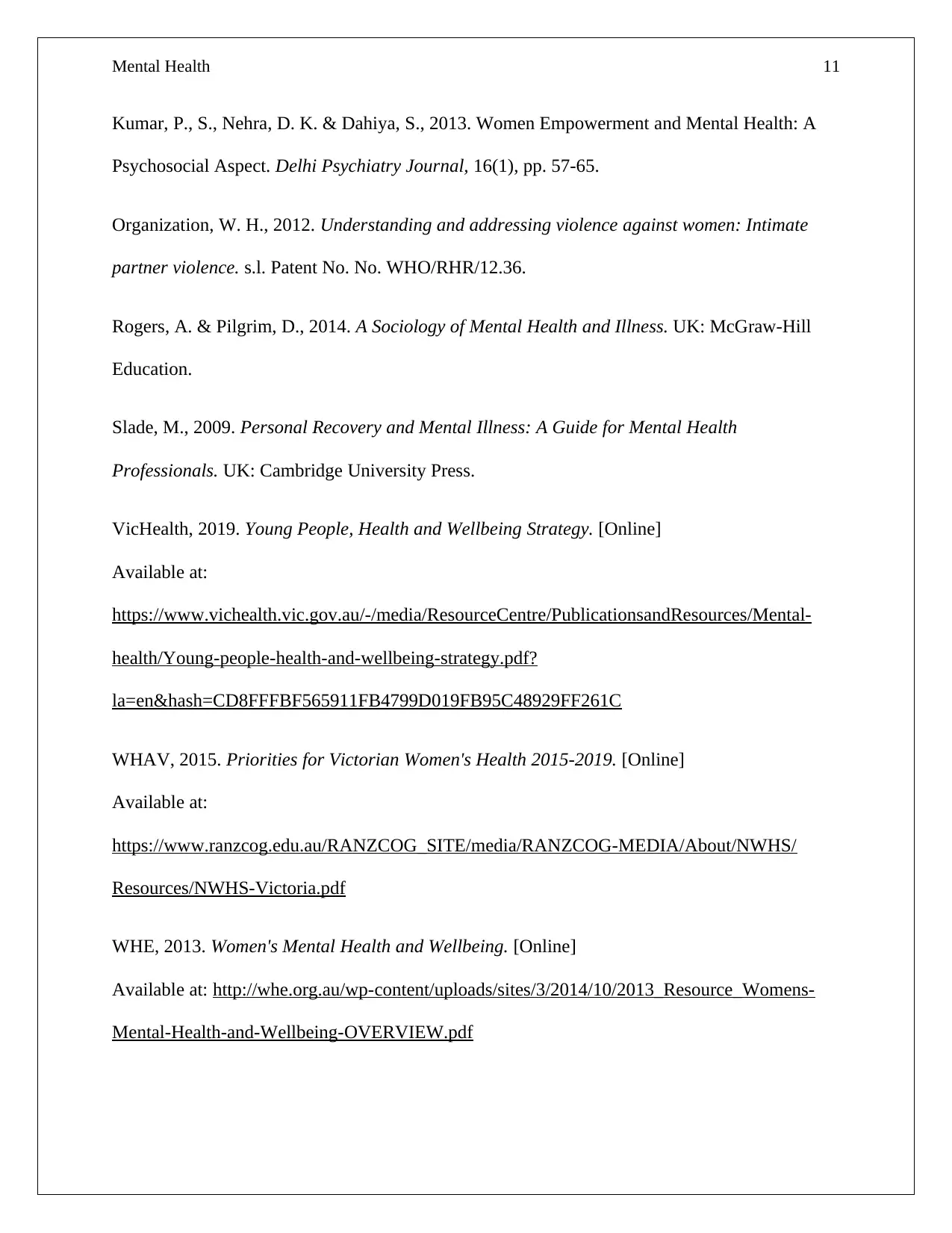
Mental Health 11
Kumar, P., S., Nehra, D. K. & Dahiya, S., 2013. Women Empowerment and Mental Health: A
Psychosocial Aspect. Delhi Psychiatry Journal, 16(1), pp. 57-65.
Organization, W. H., 2012. Understanding and addressing violence against women: Intimate
partner violence. s.l. Patent No. No. WHO/RHR/12.36.
Rogers, A. & Pilgrim, D., 2014. A Sociology of Mental Health and Illness. UK: McGraw-Hill
Education.
Slade, M., 2009. Personal Recovery and Mental Illness: A Guide for Mental Health
Professionals. UK: Cambridge University Press.
VicHealth, 2019. Young People, Health and Wellbeing Strategy. [Online]
Available at:
https://www.vichealth.vic.gov.au/-/media/ResourceCentre/PublicationsandResources/Mental-
health/Young-people-health-and-wellbeing-strategy.pdf?
la=en&hash=CD8FFFBF565911FB4799D019FB95C48929FF261C
WHAV, 2015. Priorities for Victorian Women's Health 2015-2019. [Online]
Available at:
https://www.ranzcog.edu.au/RANZCOG_SITE/media/RANZCOG-MEDIA/About/NWHS/
Resources/NWHS-Victoria.pdf
WHE, 2013. Women's Mental Health and Wellbeing. [Online]
Available at: http://whe.org.au/wp-content/uploads/sites/3/2014/10/2013_Resource_Womens-
Mental-Health-and-Wellbeing-OVERVIEW.pdf
Kumar, P., S., Nehra, D. K. & Dahiya, S., 2013. Women Empowerment and Mental Health: A
Psychosocial Aspect. Delhi Psychiatry Journal, 16(1), pp. 57-65.
Organization, W. H., 2012. Understanding and addressing violence against women: Intimate
partner violence. s.l. Patent No. No. WHO/RHR/12.36.
Rogers, A. & Pilgrim, D., 2014. A Sociology of Mental Health and Illness. UK: McGraw-Hill
Education.
Slade, M., 2009. Personal Recovery and Mental Illness: A Guide for Mental Health
Professionals. UK: Cambridge University Press.
VicHealth, 2019. Young People, Health and Wellbeing Strategy. [Online]
Available at:
https://www.vichealth.vic.gov.au/-/media/ResourceCentre/PublicationsandResources/Mental-
health/Young-people-health-and-wellbeing-strategy.pdf?
la=en&hash=CD8FFFBF565911FB4799D019FB95C48929FF261C
WHAV, 2015. Priorities for Victorian Women's Health 2015-2019. [Online]
Available at:
https://www.ranzcog.edu.au/RANZCOG_SITE/media/RANZCOG-MEDIA/About/NWHS/
Resources/NWHS-Victoria.pdf
WHE, 2013. Women's Mental Health and Wellbeing. [Online]
Available at: http://whe.org.au/wp-content/uploads/sites/3/2014/10/2013_Resource_Womens-
Mental-Health-and-Wellbeing-OVERVIEW.pdf
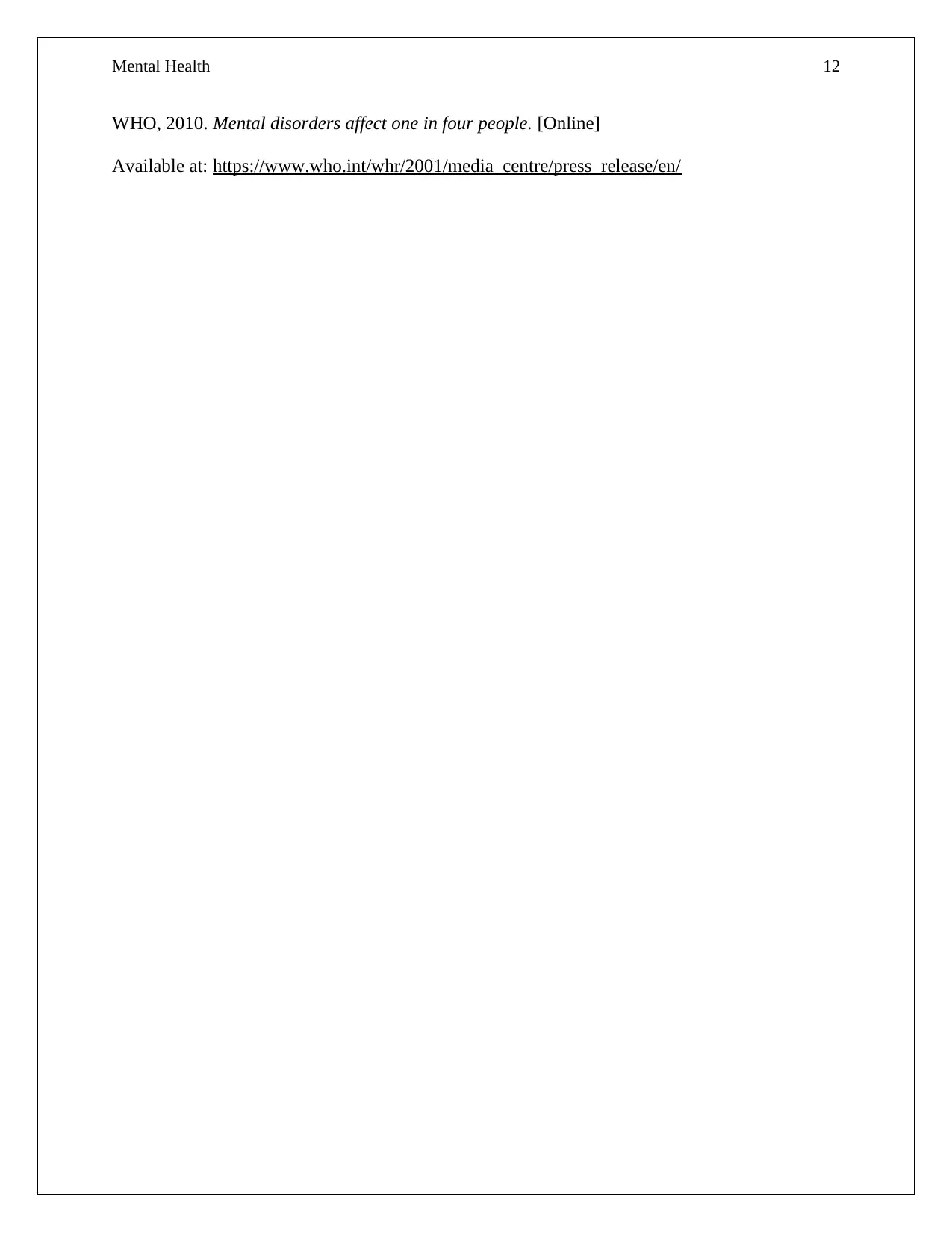
Mental Health 12
WHO, 2010. Mental disorders affect one in four people. [Online]
Available at: https://www.who.int/whr/2001/media_centre/press_release/en/
WHO, 2010. Mental disorders affect one in four people. [Online]
Available at: https://www.who.int/whr/2001/media_centre/press_release/en/
1 out of 12
Related Documents
Your All-in-One AI-Powered Toolkit for Academic Success.
+13062052269
info@desklib.com
Available 24*7 on WhatsApp / Email
![[object Object]](/_next/static/media/star-bottom.7253800d.svg)
Unlock your academic potential
© 2024 | Zucol Services PVT LTD | All rights reserved.




